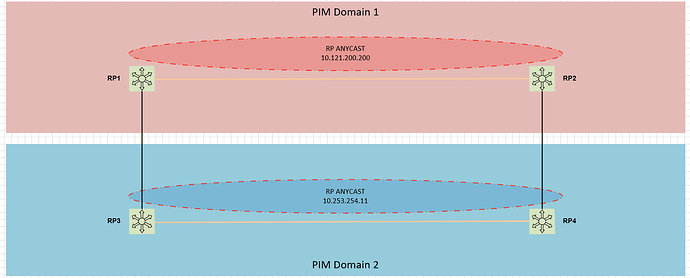Hello Sir,
Does msdp interface must use loopback interface? can I use 192.168.23.0/24 interface to msdp source interface?
Hello Eric
You can use the IP address of a physical interface to act as the MSDP source interface if you like. The feature will work correctly if you do so. However, while it’s not strictly required to use a loopback interface for MSDP, it’s highly recommended. The reason is that loopback interfaces are virtual and always up, unlike physical interfaces that can go down due to various reasons such as link failures, hardware issues, etc. Using a loopback interface for MSDP increases reliability.
So it is best practice to use a loopback interface, however, it will still work if you use physical interface.
I hope this has been helpful!
Laz
Hello,
How does MSDP works to build (S,G) all the way between the Anycast RPs?If we dont use MSDP,how is this achieved?
Thanks
Hello Kai
Take a look at this NetworkLessons note on how MSDP operates when used with Anycast RPs.
Similarly, you can take a look at this note that describes how Auto-RP and BSR can also be used as an alternative.
I hope this has been helpful!
Laz
@ReneMolenaar, great work.
If we expand this topology a little bit, and we have a site (Site B for example) that is connected through an ISP. Would I be able to do the same and build an MSDP mesh where Site A has Anycast RP of 1.1.1.1 and Site B has Anycast RP of 2.2.2.2?
Hi all,
I’m facing a concept idea about MSDP.
Let’s say i have 2 PIN domains with two RPs inside them
Is in this case the best practice to full-mesh the msdp peering between all of them ?
In other words:
- RP1 has as MSDP peer RP2,RP3 and RP4
- RP2 has as MSDP peer RP1,RP3 and RP4
- RP3 has as MSDP peer RP1,RP2 and RP4
- RP4 has as MSDP peer RP1,RP2 and RP3
or is it better to keep let’s say “single homed” connections ?
In other words:
- RP1 has as MSDP peer RP2 and RP3
- RP2 has as MSDP peer RP1 and RP4
- RP3 has as MSDP peer RP1 and RP4
- RP4 has as MSDP peer RP1 and RP3
What is the downside using the the first one or the second scenario ?
Thanks in advance.
Wish you a great day.
Aronne
Hello Ahmed
Yes, the setup you describe is definitely doable, and it is a logical way to configure multicast, Anycast RP and MSDP in a multi-site environment. This of course depends upon the requirements of your topology.
Since Anycast RP allows the use of the same RP address by multiple in different locations, each serving a different group of multicast receivers, the RP closest to the multicast source can is used. In your case, Site A and Site B can have their own Anycast RP addresses (1.1.1.1 and 2.2.2.2 respectively). You just need to ensure that the ISP supports multicast routing and allows multicast traffic.
You would also need to configure MSDP between the Anycast RPs to share the active source information. This way, if a multicast source becomes active in Site A, the Anycast RP in Site B would learn about it through MSDP, and vice versa.
I hope this has been helpful!
Laz
Hello Aronne
In the arrangement that you are describing, you have intra-domain MSDP peerings and inter-domain MSDP peerings.
The intra-domain peerings are those between RPs in the same domain. Since you have only two RPs in each domain, you simply have one peering between them. This MSDP peering of course is mandatory in order for Anycast RP to function correctly.
Inter-domain MSDP peerings are those between RPs in different PIM domains. Now the question here is, for the topology you shared, should there be a full mesh peering or a partial mesh peering? What are the benefits of each choice?
Between different PIM domains, technically, only one MSDP peering per domain is necessary. This is because RP1 and RP2 already share the same SA database within Domain 1 through their internal peering, and RP3 and RP4 do the same within Domain 2. Adding the “R1 → R4” and “R2 → R3” peerings does not provide additional value but unnecessarily increases control-plane overhead.
The best practice is to use a partial-mesh peering between PIM domains. With the partial mesh that you describe, even if one of the routers fails, you still have a second inter-domain peering that maintains the synchronization between domains.
Using a partial mesh between domains strikes a balance between redundancy, scalability, and simplicity. It ensures that multicast sources and receivers are fully visible across domains without unnecessary overhead. Does that make sense?
I hope this has been helpful!
Laz
Hi Laz,
many thanks for your feedback, all clear and helpful so far.
Since peering for anycast in the same domain is already active, you suggest to create “only” interdomain MSDP peering between R1 and R3. Also peering between R2 and R4 is needed to maintain redundancy in case of failure of R1 or R3, isn’t it ?
Thanks a lot for your support and tips.
Wish you a great day!
Aronne
Hello Aronne
Ah, I see the confusion. My suggestion was that this:
does not provide additional value compared to this:
In the second scenario, you do have multiple inter-domain peerings for redundancy, but you don’t need those extra “R1 → R4” and “R2 → R3” peerings for the reasons I explained in the previous post. I’ve rewritten my post to make that clearer.
I hope this has been helpful!
Laz
Hi Laz,
Many thanks for the explanation.
I got It now.
Wish you a great day.
Aronne
